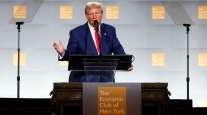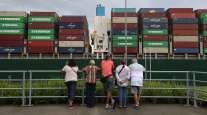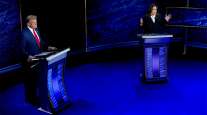Trump’s Gamble for Quick Trade Deal With China May Be Long Shot

President Donald Trump is dispatching two of his top economic deputies to China in hopes of a quick deal on trade. They may find the reality on the ground more daunting.
Trump said April 24 that Treasury Secretary Steven Mnuchin will depart for China within days. Mnuchin is expected to be accompanied by U.S. Trade Representative Robert Lighthizer.
“We have a very good chance of making a deal,” said the president, who gave no other details. If an agreement isn’t reached, the United States will follow through with a plan to impose tariffs on as much as $150 billion in Chinese imports, Trump said. China has vowed to retaliate with duties on everything from U.S. soybeans to airplanes, which has raised alarm about a trade war erupting between the world’s two largest economies.
RELATED: US hints at China truce as world warns of trade-war threat
But if recent history is a guide, the trip may be long on ceremony and short on concrete outcomes. When Trump himself visited Beijing in November, he was treated to a lavish banquet in the Forbidden City. However, the deals he announced were mostly nonbinding promises that could take years to bear fruit. A 100-day action plan on trade announced last year during a summit between Trump and Chinese President Xi Jinping did little to address trade imbalances, and a two-way formal economic dialogue has been suspended.
China Feud
It’s unlikely the sides will achieve a breakthrough that prevents the tariffs from taking effect, “given the credibility each has staked in showing resolve,” said Michael Hirson, head of China research at New York-based Eurasia Group and formerly the U.S. Treasury Department’s chief representative to Beijing.
RELATED: Global finance chiefs told trade tensions are hitting confidence
“Beijing will not make steep and immediate concessions. Xi is too confident in his political strength vis-a-vis Trump and too determined to avoid vindicating Trump’s pressure tactics.”
Fears of an escalating feud have rattled markets and prompted the International Monetary Fund to warn that trade tensions risk undermining the strongest global upswing since 2011. Business groups such as the U.S. Chamber of Commerce and a lobbying council representing major technology companies have been urging Trump to avoid a prolonged dispute that would disrupt supply chains and raise prices for consumers.
Trump said that he’ll discuss America’s unfair treatment from trading partners during a private meeting with Apple Inc. CEO Tim Cook on April 25 at the White House. Last month, Cook told attendees at a conference in Beijing that he hoped that China and the United States could resolve their differences on trade.
Wish List
It’s not clear what the United States will be asking for from China. Mnuchin has been involved in talks with Chinese Vice Premier Liu He, with the aim of getting China to make concessions on automobiles and financial services. But Trump also has suggested he’s after bigger game, asking China to cut its trade surplus with the United States by $100 billion annually and demanding that China curtail support for high-technology industries. The United States had a record $375 billion trade deficit with China last year.
RELATED: Fed economists say tariffs more likely to kill than create jobs
The outlook for talks is “quite gloomy,” said Gai Xinzhe, an analyst at Bank of China’s finance institute in Beijing.
High-Tech Demands
The United States has accused China of using policies to subsidize high-tech companies and of forcing foreign companies into transferring technology in areas such as robotics, aerospace and artificial intelligence. U.S. demands that China curtail support for high-tech industries caused talks earlier this month to break down, Bloomberg News reported.
In a speech at the Boao Forum for Asia this month, Xi pledged to open sectors from banking to auto manufacturing, increase imports, lower foreign-ownership limits on manufacturing and expand protection of intellectual-property rights — all central issues in Trump’s trade agenda. Trump welcomed the promises by China to further open up its economy.
RELATED: IMF spots trouble for global economy after 2020
“Beijing will move quickly to implement Xi’s recent commitments at Boao to cut tariffs and ease joint venture requirements in the auto sector, moves that were designed to appeal to Trump,” Hirson said. “Beijing may also agree to lower tariffs on, or increase imports of other U.S. exports, including natural gas.”
“These measures won’t put a lasting dent in the deficit, but could result in enough tweetable announcements for Trump to declare victory,” he said.
People shouldn’t read Mnuchin’s visit as a sign the Trump administration is looking for a truce, said Lu Zhengwei, chief economist at Industrial Bank Co. in Shanghai. It only shows that negotiations are taking place, he said.
“China is willing to solve the disputes, but it will never accept conditions that will be at the cost of its own development. China won’t be a slave to the U.S.,” he said.
With assistance by Kevin Hamlin, Andrew Mayeda and Miao Han




